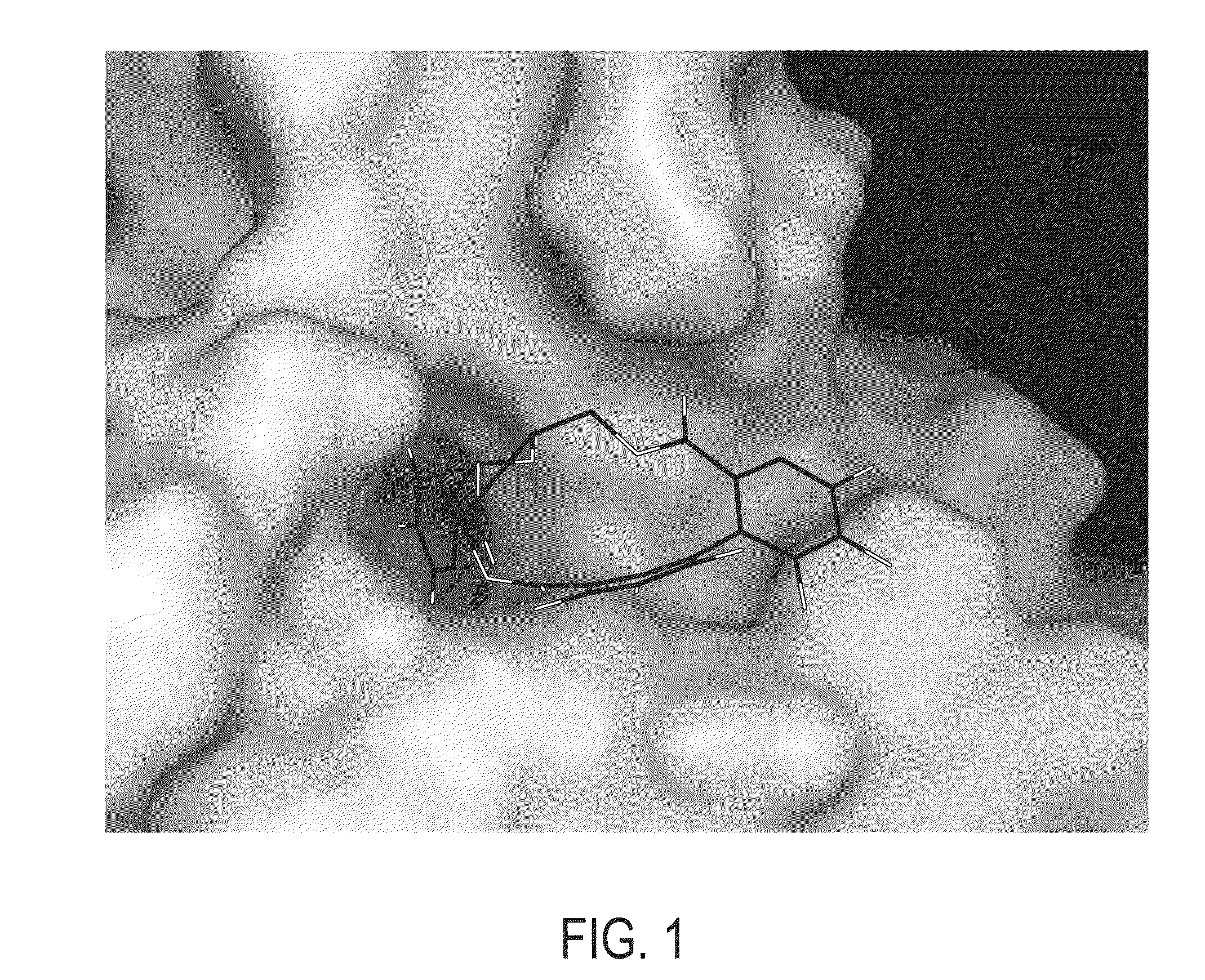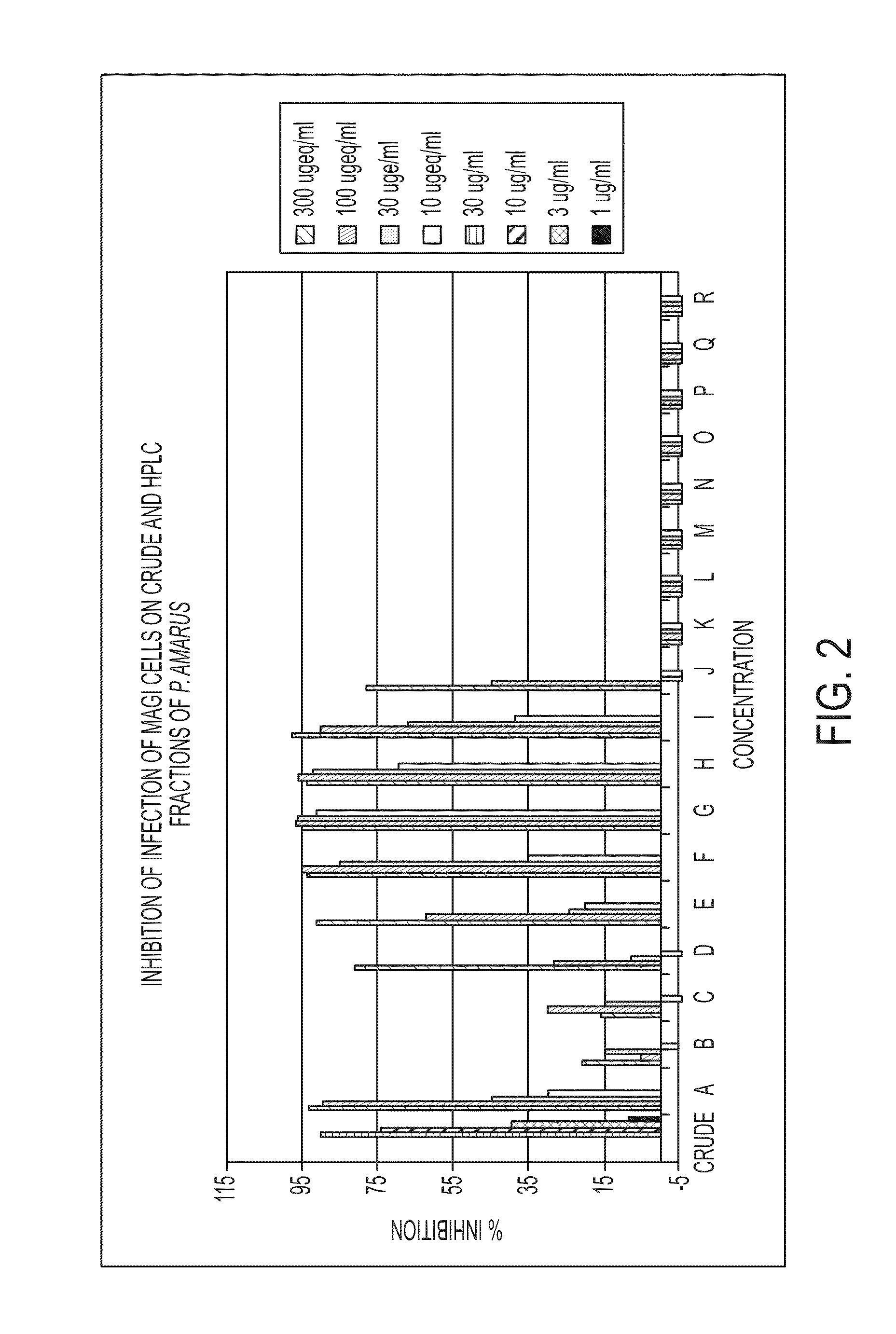Novel Phyllanthus Extract
a technology of phyllanthus and extract, which is applied in the directions of plant/algae/fungi/lichens, biocide, and separation processes, etc., can solve the problems of resistant hiv strains, serious drug-related side effects, and insufficient presence of phyllanthus alon
- Summary
- Abstract
- Description
- Claims
- Application Information
AI Technical Summary
Benefits of technology
Problems solved by technology
Method used
Image
Examples
example 1
Fractionation of Crude Phyllanthus amarus Extract
[0077]The aqueous EtOH extract (100 g) was dissolved in H2O (200 ml) and added to the top of C18 Silica gel column (17×10 cm) and fractionated by low pressure vacuum liquid chromatography (VLC). Elution was initiated with H2O (3 L), followed by stepwise elution (2 L each) with 10%, 20%, 30%, 40%, 50%, 75% and 100% MeOH in H2O. The bioactivity was located in the 10% to 50% MeOH in H2O fractions. These fractions were combined and concentrated in a rotary evaporator at 35 degrees and this represents the gallotannin fraction. This material was further fractionated using the preparative C-18 HPLC (X-terra @prepRP18, 19×30 mm, 5 μM, flow rate 12 ml / min, UV detection 210 nm and 254 nm) using the eluent water-ACN (each with 0.1% HCOOH) gradient system (1:0 to 7:3) for 60 minutes, to get the compounds geraniin, repandusinic acid, corilagin and brevifolin carboxylic acid.
example 2
Determination of gp120 Binding Constants Using Micro-Equilibrium Dialysis (mED)
[0078]Analyses were conducted using Harvard Apparatus DispoEquilibrium Dializers with 10 kDa MWCO loaded with 25 μl of 6 mg / ml of gp120 (25 μM) in PBS pH 7.2 loaded in each apparatus. Each affinity event was prescreened at 10 analyte concentrations from 0.001 to 2.5 mmol in PBS pH 7.2 for each compound screened. If needed, experiments were repeated within a smaller concentration range (i.e., 10 trials from 0.01 to 0.10 mmol). A total volume of either 50 μl was used in each analysis. Analytes were loaded in the opposite side of the membrane and equilibrium was obtained after incubation of 12 hrs at 23° C. The association constants were determined by non-linear regression analysis. Concentrations of compounds analysed were determined by HPLC analysis by comparison against an internal control (diethyl-7-dimethylaminocoumarineacetamide). HPLC controls were run with an equimolar amount of control and analyte. ...
example 3
Binding Site of Corilagin, Repandusinic Acid and Geraniin
[0080]It has been reported that there are at least two binding areas on gp120 that are bound by known inhibitors of gp120-CD4 binding. One site is bound by inhibitors that prevent conformational changes in gp120 protein upon gp120-CD4 binding (Si et al., Proceedings of the National Academy of Sciences, 101(14):5036 (2004)). It is suggested that the important residues are 112, 113, 382, 426, 125, 429, 433 and 457 (Madani et al., J. Virol., 78:3742-3752 (2004)). Other compounds have been identified that prevent the binding of gp120 to CD4 via a specific and competitive mechanism. It was shown that the essential residues are 368, 370, 371, 427, 457 and 375 (Guo et al., J. Virol., 77(19):10528-10536 (2003)). The residues corresponding to the latter site (in the following termed site I) are located into a large cavity, which is penetrated by the phenyl residue Phe43 of CD4 and hence is responsible for gp120-CD4 interaction. Interes...
PUM
| Property | Measurement | Unit |
|---|---|---|
| Fraction | aaaaa | aaaaa |
| Fraction | aaaaa | aaaaa |
| Fraction | aaaaa | aaaaa |
Abstract
Description
Claims
Application Information
 Login to View More
Login to View More - R&D
- Intellectual Property
- Life Sciences
- Materials
- Tech Scout
- Unparalleled Data Quality
- Higher Quality Content
- 60% Fewer Hallucinations
Browse by: Latest US Patents, China's latest patents, Technical Efficacy Thesaurus, Application Domain, Technology Topic, Popular Technical Reports.
© 2025 PatSnap. All rights reserved.Legal|Privacy policy|Modern Slavery Act Transparency Statement|Sitemap|About US| Contact US: help@patsnap.com



